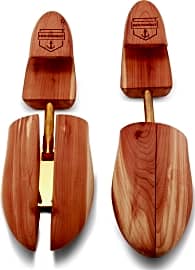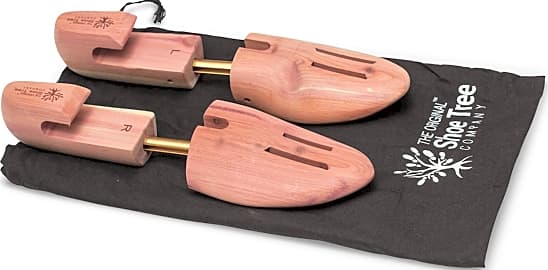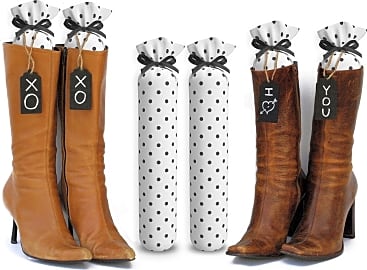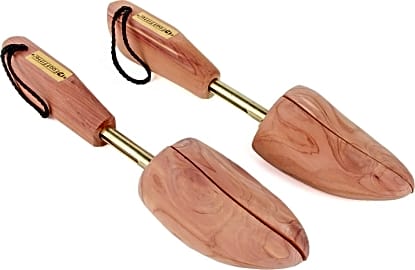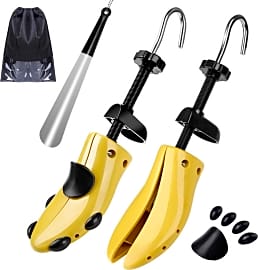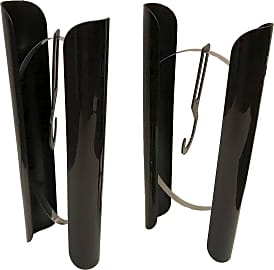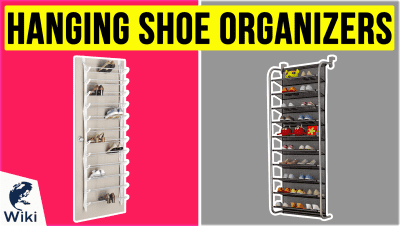The 10 Best Shoe Trees

This wiki has been updated 41 times since it was first published in March of 2015. No, shoes do not grow on trees, but you probably wish they did if you've ever had a few flatten in your closet after stuffing in one pair too many. If your footwear is taking a premature beating or you are suffering from some pinching when wearing dress shoes, these options are ideal for maintaining shape and relieving pressure points to keep you comfortably on your feet. When users buy our independently chosen editorial picks, we may earn commissions to help fund the Wiki.
Editor's Notes
April 07, 2020:
Shoe trees are indispensable if you care about keeping your footwear in good condition, but thankfully, there aren't too many factors you need to consider when purchasing a set. Size, construction, shape, price, and aesthetic appeal are among the main considerations for most people, so we sourced a variety of some of the top choices available to suit many needs.
For example, boot wearers should look into the Dial Industries Black and My Boot Trees Shapers, two options ideal for keeping the shape and integrity of boots up to the knee in pristine condition. Neither is tall enough for thigh-high boots, however, and the latter selection is a little too thin for wider styles. The Florsheim Woodard, Stratton Full Toe, HoundsBay Wide Heel and Woodlore Adjustable are all equally suitable for loafers, Oxfords, and dress shoes.
In addition to the Dial Industries Black for this latest update, we brought on the Eachway Stretcher. This selection is ideal for those with wide feet, bunions, or extremely sensitive feet that blister easily with new shoes. Once you get your footwear to the shape and size you prefer, you can then use them as regular trees to keep shoes intact. Just be aware that they have an extension that juts out from the back, making storage and travel tricky.
It's important to keep in mind that shoe trees cannot fix every shoe problem. If your interiors suffer from moisture and constant wear, then a shoe tree might easily scrape it in its weakened state. Treating your shoe linings with a good conditioner if they're leather or regularly airing them out and letting moisture dissipate will go a long way in keeping them pristine. If you sweat profusely or live in a wet climate, consider picking up a shoe dryer.
Special Honors
Luxury Trees from The Hanger Project Trees made by the Hanger Project are created with meticulous care and attention and crafted from woods like sapele, obeche, cedar, and maple. They come in a variety of finishes and colors and sport polished hardware, high vamps, and modern, sculpted designs. Pieces are manufactured in Northampton, England to exact specifications and are among those used by some of the world's top shoemakers. hangerproject.com
The Shoe Snob Alder This offering from The Shoe Snob is attractive and functional, crafted from deep crimson alder wood, which absorbs moisture from sweat and rain like cedar, but has no aromatic scent. It sports a shape that rests well in the majority of footwear, with a generous size that fills your entire shoe to keep it intact without leaving loose areas. theshoesnob.com
Getting The Best Fit From Your Shoes
Remember that just as your new shoes must adjust to your feet, so too must your feet adjust to a new pair of shoes.
A pair of shoes should look great and feel even better. A shoe's primary purpose is to support and protect your foot, and a well-made shoe will reduce the fatigue and soreness you feel after long hours spent standing or walking. But even the finest shoes are rarely comfortable the first time you put them on your feet. Every shoe, ranging from a pair of women's dress heels to hiking boots to a casual pair of loafers, requires a period of breaking in before they will be their most comfortable.
To break in shoes without causing pain or even injury to your feet, you can initially wear the new shoes for short periods of time. Wear them for ten to fifteen minutes while walking and standing at your home or office, switching to well-worn comfortable shoes (or simply remaining barefoot or in socks) while in the interim. Remember that just as your new shoes must adjust to your feet, so too must your feet adjust to a new pair of shoes.
The skin at the back of your heels are particularly prone to blistering when adjusting to the fit of a new shoe, but it will quickly toughen and resist additional damage. Taking the shoe break-in process slowly can prevent the formation of blisters, which can be so painful they force you to abandon the shoes altogether.
If your new shoes require any significant stretching out before they will be comfortable, there are many methods beyond simply wearing them that you can try. Applying heat to a leather shoe using a hair dryer can help soften the material, making it more pliant when you slide your foot in immediately following the warming process. On quite the opposite end of the spectrum, you can also use ice to help stretch a shoe.
This approach involves sliding baggies filled with water into your shoes and then placing the shoes in the freezer. As the water freezes, it will expand and slowly, steadily, and evenly stretch out the shoe. This method risks water damage, though, and is a rather involved undertaking. (Some people may also balk at the idea of putting shoes near their frozen foods, though this can be mitigated by placing the shoes in a larger plastic bag.)
By far the simplest, most reliable way to stretch out a pair of shoes other than wearing them is to use a shoe tree. These purpose-built items can quickly help to make your shoes more comfortable, and they can help shoes retain their shape and appearance even after years of use.
Choosing A Shoe Tree For Comfort
All shoe trees are designed to stretch your shoe across their long axis, which is to say from the toe box (the area that surrounds and protects the toes) to the heel. This type of stretch can help reduce the pressure you feel on your toes, which is usually the area with the most pronounced friction and discomfort caused by newer shoes. However, anyone with a wider foot, irregularities to their toe shape, or with a foot given to discomfort in any other areas, a shoe tree that merely stretches the shoe in length may not suffice.
Many shoe trees are adjustable to spread out in the shoe's toe box, widening the shoe to more comfortably accommodate its wearer's foot.
Many shoe trees are adjustable to spread out in the shoe's toe box, widening the shoe to more comfortably accommodate its wearer's foot. Shoe trees offering this type of stretching can potentially help even those with wider feet to enjoy regular shoes. Some shoe trees even come with additional hardware that can be attached to create customized relief areas, stretching out a shoe right where you need it.
Make sure you select the right specialty shoe tree for heels or dress shoes, and make sure to note whether or not the tree you're considering is gender-specific or not. Also consider the shoe tree's material: cedar wood can reduce odors and draw out moisture, resulting in a dry, comfortable shoe when you're ready to wear it.
And if you plan to use your tree to help a shoe maintain its shape between wearings, make sure to slightly reduce the tension settings you used during its break in stage: once a shoe fits your foot comfortably, it's unlikely it will shrink again, so there is no need to apply excess pressure during its storage.
Choosing A Shoe Tree For Pain Relief
Shoe comfort is important for everyone, but it is critical for those with feet afflicted by bunions, arch issues, or any other ailment caused by genectics, injury, age, surgery, and so forth. Using a shoe tree to reduce the pressure a shoe puts on the compromised area is far better than simply trying to wear the shoe and fight through the pain of the breaking in process.
This is especially true with the all-too-common and painful condition of bunions, which can be caused by a number of issues, especially by the chronic use of tight shoes. A bunion can always get worse, leading to more pain, less mobility, and potentially the need for surgical intervention. To help reduce exacerbation of your bunions, use a shoe tree that can stretch out your shoe's toe box and keep the pressure off of your big toe joint.
If you have arch or mid-foot issues, make sure to choose a shoe tree that can stretch the upper section of the shoe, reducing the pressure on your arches and accommodating any orthotic inserts you might require. Consider consulting your podiatrist prior to selecting a shoe tree or even to get advice about the process of making your shoes more customized and comfortable.



